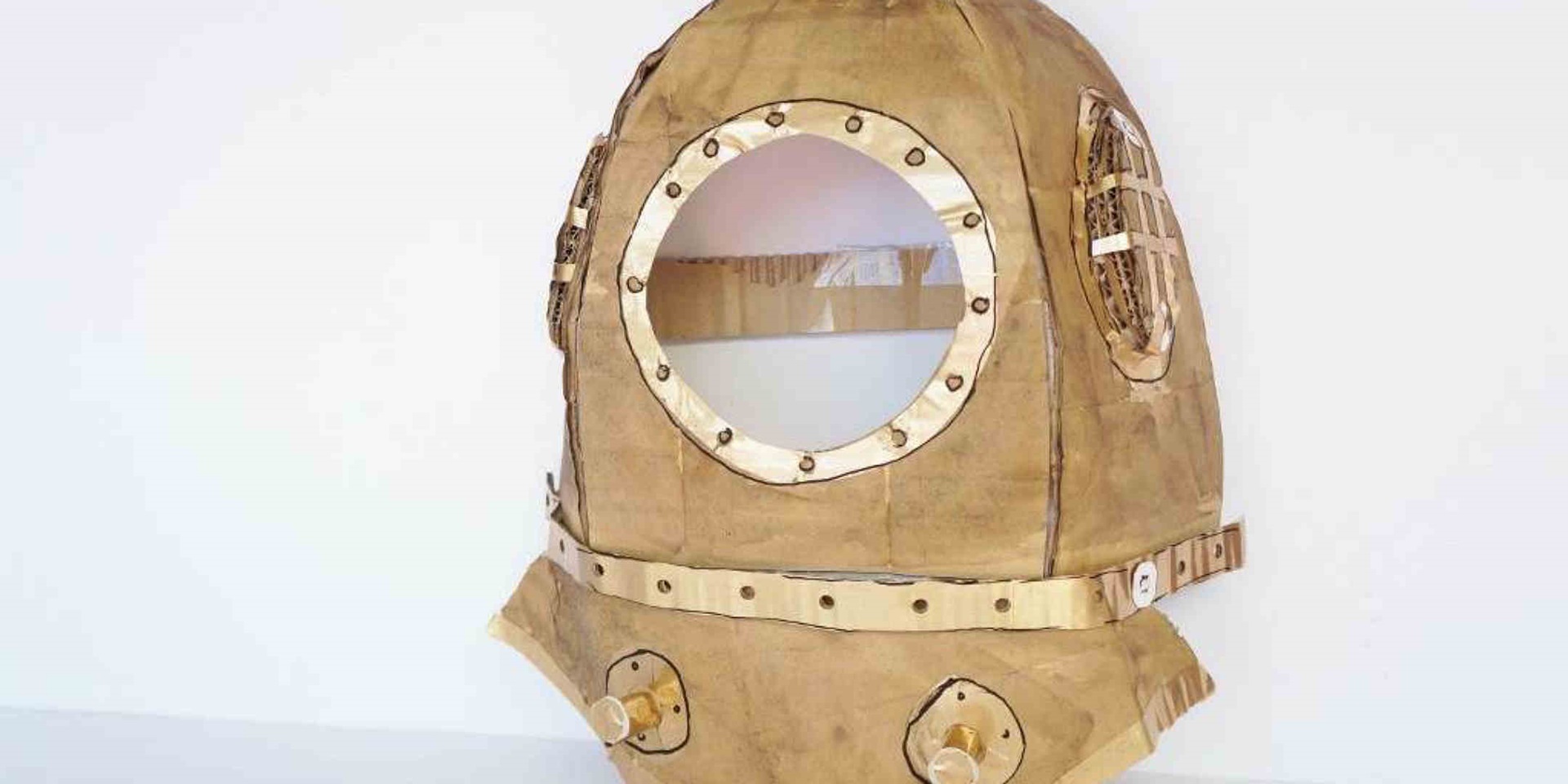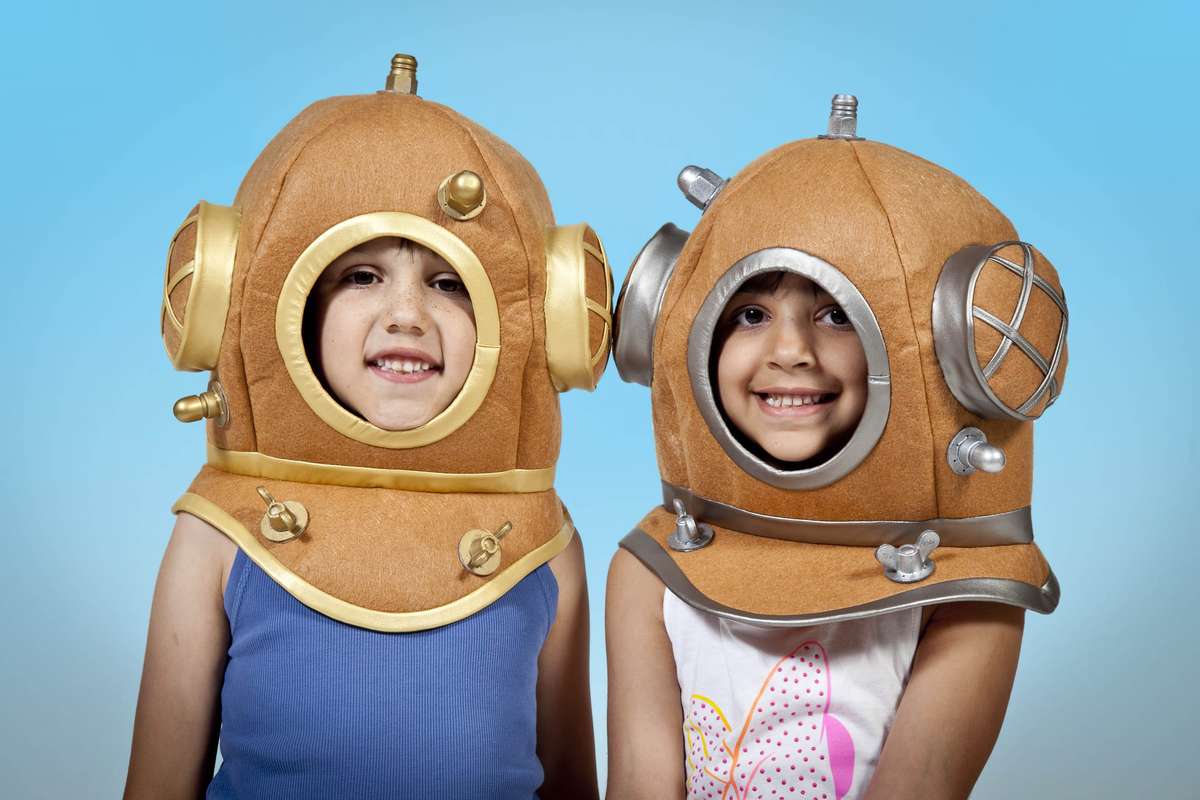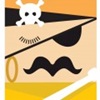
What might there be at the bottom of the sea? Oceans galore for you to explore; a shipwreck’s sunken treasure, a fearsome colossal squid, a stealthy submarine or a deep sea diver, out to explore the ocean’s floor.

This month’s kids craft spot is an adaptation of how to create a simple diver’s helmet like this for dress-ups and pretend play. Instead of fabric we’ve used some easy, accessible materials you might just have lying around at home when a certain little someone asks “what are we doing for craft today?”

The finished diving helmet

Materials
- Cardboard box
- Stanley knife (for grown-ups to do the cutting) or make do safe saw tool for kids
- Large (51 mm) paper binders
- Gold/bronze coloured contact paper (or you could use coloured paper and glue)
- Scissors
- Hole punch
- Gaff tape/cloth tape/masking tape
- Black marker
- A4 printouts of our diving helmet templates (Page 1, Page 2, Page 3)
Optional materials
- black/brown watercolour paint
- a spongey brush
- glue
- glitter or sequins if you want some extra sparkle

Step 1
Cut out all your diving helmet template shapes and trace them onto your cardboard.
HINT: We’ve made our helmet open at the back so it’s easy to pop on and off for dress ups, however if you wanted to, you can make three more helmet sides (but without a face hole) and another helmet base shape to add to the back to make a full helmet.

Step 2
HINT: Grown up help required for this step!
Cut out all your diving bell pieces with a Stanley knife or sharp scissors. In addition to the pattern pieces you will need a strip of card (roughly 30-40 cm long and 2.5cm wide) for the diving helmet join piece.
If you have plenty of time and patience you could also let the kids help with this step using a plastic box-cutting knife or kids scissors.




Step 3
Use your hands to scrunch and bend the cardboard pieces all over so they are less stiff. This will make it easier to form the curved helmet shape. Use the gaff tape to tape the pieces together from the inside.
HINT: Use the side with your sketchy outlines or any sticky tape/marks as the inside so that your outside is smooth and easy to decorate.


Step 4
Create your raised window panes for the sides.
For each window pane, place the 4 window pieces of card together and pin with a paper fastener threaded through each end like a sandwich toothpick.
Then use the paper fasteners to secure the windows to the helmet, bending the split pin ends from the inside.

Step 5
Now it’s time to decorate! Cut out gold/bronze contact strips (or paper if that’s what you are using) to make the cross hatching on the sides. Cover the helmet joiner, trim the helmet bottom and surround the face hole and windows.



Step 6
You might like to hole punch the face hole and helmet join decorations to create a more textured effect.
Add all your decorative contact pieces to the helmet.


You might even like to add some extra nuts, bolts or cogs made from any leftover scraps of card and contact and secured to the helmet with paper fasteners.
If you’re keen on sparkle, extra sequins or glitter can also be glued on here.


Step 7
You could stop decorating now, however, we thought our helmet needed a little something.
If you agree, use a bit of watercolour paint and a spongey brush all over to give your cardboard an antique-y bronze look.
Add extra definition by outlining your gold trim with a black marker.

Step 8
Add a cardboard band to the back that can be adjusted to head size with tape or staples.
Make sure all your paper fastener ends are taped over on the inside so that they don’t scratch little faces.

And there it is. Suit up little aquanauts, it’s time to dive!
